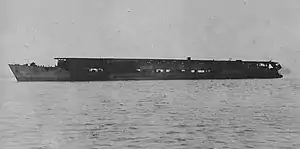 Yamashio Maru | |
| Class overview | |
|---|---|
| Builders | Mitsubishi Heavy Industries |
| Operators | |
| Preceded by | Akitsu Maru class |
| Succeeded by | Kumano Maru |
| Built | 1944–1945 |
| In commission | 1945 |
| Planned | 2 |
| Completed | 1 |
| Cancelled | 1 |
| Lost | 1 |
| General characteristics | |
| Type | Escort carrier |
| Displacement | 16,119 tonnes (15,864 long tons) |
| Length | 157.5 m (516 ft 9 in) |
| Beam | 20.48 m (67 ft 2 in) |
| Draught | 9 m (29 ft 6 in) |
| Installed power | |
| Propulsion |
|
| Speed | 15 knots (28 km/h; 17 mph) |
| Range | 9,000 nmi (17,000 km; 10,000 mi) at 13 knots (24 km/h; 15 mph) |
| Complement | 221 |
| Armament |
|
| Aircraft carried | 8 |
The Yamashio Maru class (Japanese: 山汐丸) consisted of a pair of auxiliary escort carriers operated by the Imperial Japanese Army during World War II. They were converted from tankers. Only the name ship was completed during the war and she was sunk by American aircraft before she could be used.
Construction
In 1944, the Japanese Army, which had already converted two passenger liners into combined assault ship and aircraft carriers, decided to acquire its own escort carriers to provide aerial anti-submarine cover for troop convoys. It therefore chartered two partly built Type 2TL Tankers, Yamashio Maru and Chigusa Maru, for conversion to auxiliary escort carriers.[1]
The conversion was extremely simple, with a 107-metre (351 ft 1 in)-long flush flight deck added. There was no hangar, the ship's eight Ki-76s being stored on deck. Defensive armament consisted of sixteen 25 mm anti-aircraft guns, with a depth charge projector forward.[2]
Operational history
Yamashio Maru commissioned on 27 January 1945 and was sunk at Yokohama harbor by US aircraft on 17 February.[2][3] Plans were drawn up for conversion to a coal-burning freighter,[1] but she was never used as a carrier. Her sister ships, Chigusa Maru and Zuiun Maru, were incomplete when Japan surrendered and served after the war as tankers:[2]
Chigusa Maru was sunk in 1945. The ship was repaired as tanker in 1945 and scrapped in Sasebo in June 1963. Zuiun Maru was scrapped in Oskata on 15 June 1964.
Photo
 Chigusa Maru postwar (2nd sister)
Chigusa Maru postwar (2nd sister) Zuiun Maru postwar (3rd sister)
Zuiun Maru postwar (3rd sister)
See also
Notes
Bibliography
- Chesneau, Roger (1995). Aircraft Carriers of the World, 1914 to the Present: An Illustrated Encyclopedia (New, revised ed.). Annapolis, Maryland: Naval Institute Press. ISBN 0-87021-902-2.
- Chesneau, Roger, ed. (1980). Conway's All the World's Fighting Ships 1922-1946. Greenwich, UK: Conway Maritime Press. ISBN 0-85177-146-7.
- Fukui, Shizuo (1991). Japanese Naval Vessels at the End of World War II. London: Greenhill Books. ISBN 1-85367-125-8.
- Jentschura, Hansgeorg; Jung, Dieter; Mickel, Peter (1977). Warships of the Imperial Japanese Navy, 1869–1945. Annapolis, Maryland: United States Naval Institute. ISBN 0-87021-893-X.
- Polmar, Norman; Genda, Minoru (2006). Aircraft Carriers: A History of Carrier Aviation and Its Influence on World Events. Vol. 1, 1909–1945. Washington, D.C.: Potomac Books. ISBN 1-57488-663-0.